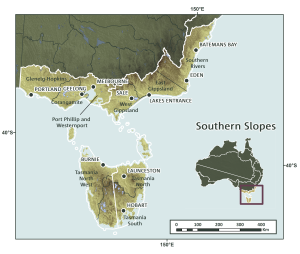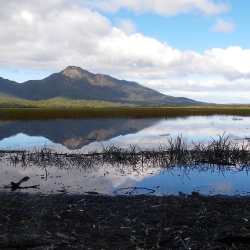Climate Change in Australia
Climate information, projections, tools and data
About Southern Slopes
The Southern Slopes Cluster (SSC) covers an area of almost 225,000 km2 across Tasmania, Victoria and New South Wales. It comprises the nine natural resource management regions of south-eastern Australia that share a cool maritime climate. These are:
- the five Victorian coastal Catchment Management Authorities (CMAs); Glenelg Hopkins, Corangamite, Port Philip/ Westernport, West Gippsland and East Gippsland;
- the three Tasmanian Natural Resource Management (NRM) organisations; NRM North, NRM South and Cradle Coast NRM, and
- the NSW South East Local Land Services (SE LLS).

Key Messages & Issues
The SSC lies within the ‘mid-latitudes’ of the global climate system and experiences a range of climate influences and drivers. In combination with the diverse land forms, these climate drivers result in a many different bioclimatic zones. The Cluster includes many of the coolest, high-altitude regions of Australia as well as the extensive basalt plains of western Victoria and lowland coastal regions. In summary:
1. Annual mean temperatures range from 8°C -14°C.
2. Annual mean precipitation ranges from around 400 – 3700mm.
3. Vegetation types, hydrology regimes and land-uses vary greatly across the SSC.
The NRM organisations across the Cluster are working closely with
researchers to identify likely climate change impacts and options for
adaptation across each NRM/CMA region. A pathways approach to climate
change adaptation is being developed to help ensure that the adaptation
strategies that are incorporated into NRM planning are robust across a
range of futures whilst being flexible enough to be adjusted if needed.
An
adaptation pathways approach accommodates an uncertain future and
recognises that there is rarely (if ever) a singular, optimal solution,
especially in NRM where trade-offs between public and private benefits
and short-term and long-term outcomes are commonplace.

Background to Research
Since the commencement of the SSC partnership project in early 2013, representatives from all Stream 1 SSC NRM organisations and Stream 2 researchers have met regularly, both formally and informally, to identify and prioritise what climate change impacts and adaptation information is required for NRM planning and its implementation. An iterative approach to developing useful information and building the capacity to apply it well has been targeted to develop robust plans and processes for climate change adaptation and mitigation. The intended outcome is a legacy of information and approaches for future NRM planning, strategy development and implementation.
To date, this process has involved;
- developing and testing a framework for analysis of regional planning needs and capacities.
- developing strong linkages with NRM planners and other projects across the SSC and other clusters
- analysis of regions/CMA catchment plans and strategies with climate impacts and adaptation lens.
- undertaking interviews across NRM regions and analysing results to understand needs and capacity.
- targeted synthesis of currently available climate impacts and adaptation information.
- production of a first pass report on adaptation options and pathways.
- undertaking workshops to prioritise options for science and adaptation interventions in later stages of project, and more recently,
- defining and commencement of four sub-projects and arranging associated sub -contracting as follows:
- Sub project 1: Developing Frameworks for Adaptation Pathways
- Sub project 2: Spatial adaptation priorities for NRM implementation
- Sub project 3: Climate Change Impacts Synthesis and Assessment
- Sub project 4: Learning and knowledge brokering for NRM adaptation



